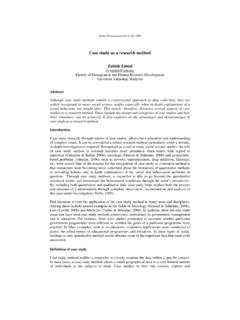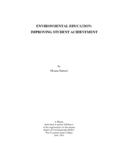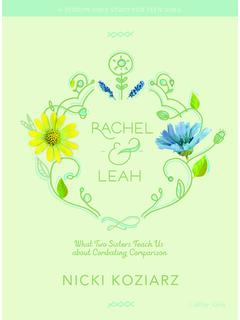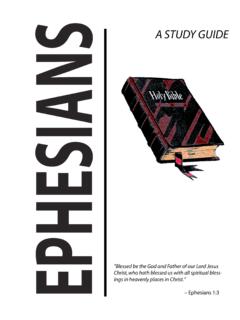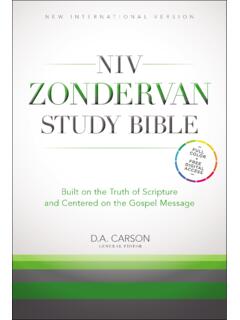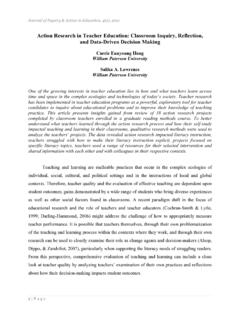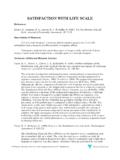Transcription of Building Theories from Case Study Research Kathleen M ...
1 Building Theories from Case Study ResearchKathleen M. EisenhardtThe Academy of Management Review, Vol. 14, No. 4. (Oct., 1989), pp. URL: Academy of Management Reviewis currently published by Academy of use of the JSTOR archive indicates your acceptance of JSTOR's Terms and Conditions of Use, available JSTOR's Terms and Conditions of Use provides, in part, that unless you have obtainedprior permission, you may not download an entire issue of a journal or multiple copies of articles, and you may use content inthe JSTOR archive only for your personal, non-commercial contact the publisher regarding any further use of this work. Publisher contact information may be obtained copy of any part of a JSTOR transmission must contain the same copyright notice that appears on the screen or printedpage of such JSTOR Archive is a trusted digital repository providing for long-term preservation and access to leading academicjournals and scholarly literature from around the world.
2 The Archive is supported by libraries, scholarly societies, publishers,and foundations. It is an initiative of JSTOR, a not-for-profit organization with a mission to help the scholarly community takeadvantage of advances in technology. For more information regarding JSTOR, please contact Jul 31 21:07:56 2007F Academy ofManagement Review, 1989, Vol 14, No 4, 532-550 Building Theories from Case Study Research Kathleen M. EISENHARDT Stanford University This paper describes the process of inducting theory using case stud- ies-from specifying the Research questions to reaching closure. Some features of the process, such as problem definition and con- struct validation, are similar to hypothesis-testing Research . Others, such as within-case analysis and replication logic, are unique to the inductive, case-oriented process.
3 Overall, the process described here is highly iterative and tightly linked to data. This Research approach is especially appropriate in new topic areas. The resultant theory is often novel, testable, and empirically valid. Finally, framebreaking insights, the tests of good theory , parsimony, logical coherence), and convincing grounding in the evidence are the key criteria for evaluating this type of Research . Development of theory is a central activity in lack of clarity about the process of actually organizational Research . Traditionally, authors Building theory from cases, especially regard- have developed theory by combining observa- ing the central inductive process and the role of tions from previous literature, common sense, literature. Glaser and Strauss (1967) and more and experience.
4 However, the tie to actual data recently Strauss (1987) have outlined pieces of has often been tenuous (Perrow, 1986; Pfeffer, the process, but theirs is a prescribed formula, 1982). Yet, as Glaser and Strauss (1967) argue, it and new ideas have emerged from methodolo- is the intimate connection with empirical reality gists ( , Yin, 1984; Miles & Huberman, 1984) that permits the development of a testable, rel- and researchers conducting this type of re-evant, and valid theory. search ( , Gersick, 1988; Harris & Sutton, This paper describes Building Theories from 1986; Eisenhardt & Bourgeois, 1988). Also, it ap- case studies. Several aspects of this process are pears that no one has explicitly examined when discussed in the literature. For example, Glaser this theory- Building approach is likely to be and Strauss (1967) detailed a comparative fruitful and what its strengths and weaknesses method for developing grounded theory, Yin may be.
5 (1981, 1984) described the design of case Study This paper attempts to make two contributions Research , and Miles and Huberman (1984) codi- to the literature. The first is a roadmap for build- fied a series of procedures for analyzing quali- ing Theories from case Study Research . This tative data. However, confusion surrounds the roadmap synthesizes previous work on qualita- distinctions among qualitative data, inductive tive methods ( , Miles & Huberman, 1984), the logic, and case Study Research . Also, there is a design of case Study Research ( , Yin, 1981, 1984), and grounded theory Building ( , Gla- search than has existed in the past. This frame- ser & Strauss, 1967) and extends that work in work is summarized in Table 1. areas such as a priori specification of constructs, The second contribution is positioning theory triangulation of multiple investigators, within- Building from case studies into the larger context case and cross-case analyses, and the role of of social science Research .
6 For example, the pa- existing literature. The result is a more nearly per explores strengths and weaknesses of theory complete roadmap for executing this type of re- Building from case studies, situations in which it Table 1 Process of Building Theory from Case Study Research Step Activity Reason Gettlng Started Definition of Research question Focuses efforts Posslbly a prlorl constructs Provldes better grounding of construct measures Nelther theory nor hypotheses Retains theoretical flexibility Selecting Cases Specified population Constrains extraneous varlation and sharpens external validlty Theoretical, not random, sampling Focuses efforts on theoretically useful , those that replicate or extend theory by filllng conceptual categories Craftlng Instruments Multiple data collection methods Strengthens grounding of theory by and Protocols triangulation of evldence Qualitative and quantitative data combined Synerglstlc vlew of evldence Multiple lnvestlgators Fosters divergent perspectives and strengthens grounding Entering the Fleld Overlap data collection and analysis.
7 Speeds analyses and reveals helpful Including field notes adjustments to data collection Flexible and opportunistic data collection Allows investigators to take advantage of methods emergent themes and unique case features Anaiyzlng Data Withln-case analysls Gains famlllarlty with data and preliminary theory generation Cross-case pattern search using divergent Forces investigators to look beyond lnitlal techniques impressions and see evidence thru multiple lenses Shaping Hypotheses Iterative tabulation of evldence for each Sharpens construct definition, validity, and construct measurability Repllcatlon, not sampling, loglc across Confirms, extends, and sharpens theory cases Search evldence for "why" behind Bullds Internal valldity relationships Enfolding Literature Comparison with conflicting literature Builds internal valldity, raises theoretical level, and sharpens construct definitions Comparison with similar literature Sharpens generallzability, improves construct definition, and ralses theoretical level Reachlng Closure Theoretical saturation when possible Ends process when marglnal Improvement becomes small is an attractive Research approach, and some guidelines for evaluating this type of Research .
8 Background Several pieces of the process of Building the- ory from case Study Research have appeared in the literature. One is the work on grounded the- ory Building by Glaser and Strauss (1967) and, more recently, Strauss (1987). These authors have detailed their comparative method for de- veloping grounded theory. The method relies on continuous comparison of data and theory be- ginning with data collection. It emphasizes both the emergence of theoretical categories solely from evidence and an incremental approach to case selection and data gathering. More recently, Yin (1981, 1984) has described the design of case Study Research . He has de- fined the case Study as a Research strategy, de- veloped a typology of case Study designs, and described the replication logic which is essential to multiple case analysis.
9 His approach also stresses bringing the concerns of validity and reliability in experimental Research design to the design of case Study Research . Miles and Huberman (1984) have outlined specific techniques for analyzing qualitative data. Their ideas include a variety of devices such as tabular displays and graphs to manage and present qualitative data, without destroying the meaning of the data through intensive cod- ing. A number of active researchers also have un- dertaken their own variations and additions to the earlier methodological work ( , Gersick, 1988; Leonard-Barton, 1988; Harris & Sutton, 1986). Many of these authors acknowledge a debt to previous work, but they have also devel- oped their own "homegrown" techniques for Building theory from cases. For example, Sutton and Callahan (1987) pioneered a clever use of a resident devil's advocate, the Warwick group (Pettigrew, 1988) added triangulation of investi- gators, and my colleague and I (Bourgeois & Eisenhardt, 1988) developed cross-case analysis techniques.
10 Finally, the work of others such as Van Maa- nen (1988) on ethnography, Jick (1979) on trian- gulation of data types, and Mintzberg (1979) on direct Research has provided additional pieces for a framework of Building theory from case Study Research . As a result, many pieces of the theory- Building process are evident in the literature. Nevertheless, at the same time, there is substan- tial confusion about how to combine them, when to conduct this type of Study , and how to evaluate it. The Case Study Approach The case Study is a Research strategy which focuses on understanding the dynamics present within single settings. Examples of case Study Research include Selznick's (1949) description of TVA, Allison's (197 1) Study of the Cuban missile crisis, and Pettigrew's (1973) Research on deci- sion making at a British retailer.
